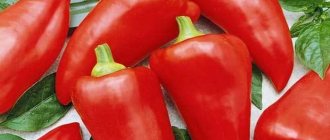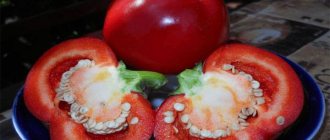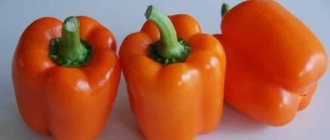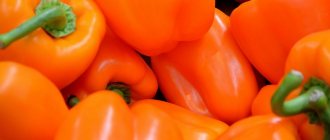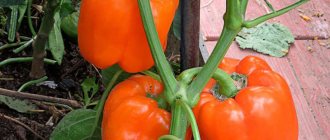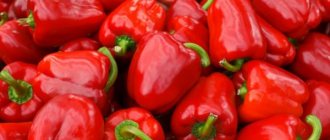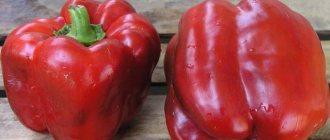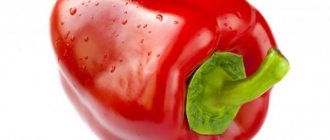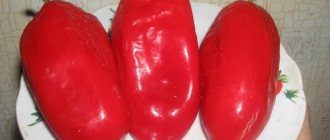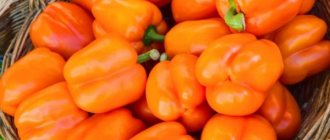Varieties of varieties
Any type of Giant F1 has a pleasant taste and all the advantages of the variety, but there are also differences.
Red Giant
This pepper contains a lot of beta-carotene. There is even more of it in it than in carrots. Also contains pectin and vitamin C. This type is mid-season. The bush is about a meter in height, the fruits are large, shaped like a cube. The pulp is juicy and very tasty. Used to prepare fresh salads, it perfectly complements the famous ratatouille.
To get a good harvest, you need to use high-quality seeds. The most productive varieties are possible. Large selection of varieties for every taste.
Yellow Giant
This sweet pepper is an early ripening one. It perfectly complements fresh salads and is often used in canning (it is especially tasty in combination with cucumbers).
This variety does not contain beta-carotene, but it is very high in vitamin C. This Giant, unlike many other varieties of pepper, loves direct sunlight. By the way, due to its high growth, it perfectly performs the function of shading, so that less light-loving varieties can be placed in the middle, and it can be planted along the edges of the bed.
Orange Giant
The variety is mid-season. The bushes are spreading, powerful, the fruits are large, sweet, aromatic and juicy. They are used fresh and are great for stuffing. This subspecies was bred specifically for consumption by people who cannot eat red vegetables due to allergies. It contains a lot of potassium, vitamin C and pectin, and has a positive effect on the entire body. It has an important growing feature. Bushes should be placed at a distance of a meter from each other and in a checkerboard pattern. To increase the number of ovaries, you can tear off the 5th and 6th flowers on each branch.
Chinese Giant
This is a super early ripening variety. The color of the fruit is red, the shape is cubic, the vitamin content is huge. It is mainly grown in a greenhouse, but can also be planted in open ground. It is resistant to temperature changes, diseases and pests, but gives the best results in greenhouses. It acquires optimal taste after reddening.
Characteristics of Giant pepper
The king of sweet peppers - this is how this variety can be called without a shadow of a doubt. In terms of beta-carotene content, red peppers are much superior to carrots. Pepper pulp is also rich in pectin. This is a dietary food product - the calorie content of pepper per 100 grams is no more than 27 kcal.
The variety is classified as mid-season. But for lovers of sweet vegetables, it is not critical to wait two weeks and then enjoy the delicious fruits. With proper care, the bush can grow up to a meter in height. The fruits ripen on it are large and cubic in shape. Its walls are quite fleshy and very juicy. The pods are best suited for canning, since the ascorbic acid they contain only contributes to this. Despite its large size, this pepper can also be stuffed. But in salads and in various dishes, the size of the pods does not matter at all.
Read also: Dried apples for pancreatitis
Bon Appetit F1
Bon Appetit F1 is a hybrid that is valued for its taste. It belongs to the mid-season varieties. The harvest is harvested 110 days after the appearance of the first shoots. The average yield is 1.5 kg per 1 sq. m. Compared to the description of the yield indicators of other varieties, the Bon Appetit hybrid has a low yield. It is difficult to find a hybrid that would produce the same sweet fruits as Bon Appetit. The weight of ripened fruits is 200 g, which allows us to classify Bon Appetit F1 as a large-fruited variety. The length of the cylindrical peppers, colored deep red, is 18 cm.
Growing
Tall bushes need tying and shaping. Sowing of seeds is carried out in the second half of February and early March. In the Moscow region and regions with a similar climate, seedlings are transplanted into the ground in mid-May. In cold regions, it is worth holding off on planting plants in the ground or constructing a film cover for them.
Characteristics and description of the variety
Giant F1 is an early ripening variety. It got its name not only because of the size of the fruit, but also because of the tall growth of the bushes. On average, they reach 110 cm, so supports are required when growing, but powerful stems must be tied up carefully so as not to accidentally break them. To do this, they do not use ropes or threads, but wide cotton strips of fabric (old bed linen is often used).
At the same time, keep in mind that additional fastening is needed not only for the main stem, but also for the side branches. If you form the plant correctly, it will be quite spreading.
The fruits reach an unrealistic length for a pepper - 20 cm. And the weight is impressive. On average it is 300 gr. The fruits can be of different colors, but we will dwell on the varieties a little later.
What all types have in common is a change in color depending on the degree of ripeness, a sweet taste, as well as thick walls and fleshy, dense pulp.
It is believed that Gigant F1 pepper is best suited for canning and freezing, but even in fresh form its quality is more than excellent.
The benefits of this variety should also be noted. Red has a lot of beta-carotene, yellow has vitamin C, and orange has pectin.
You can grow Giant F1 with equal success both in open and closed ground. Climatic conditions can also be any. The minimum yield is 4-5 kg per meter kW, with proper care and additional feeding it reaches 10 kg.
Features of growing sweet peppers, planting and care
Sowing seeds for seedlings is carried out 65-70 days before the intended planting of plants in a permanent place. The optimal temperature for seed germination is 26-28°C. Shoots usually appear after 12-15 days.
When true leaves appear on the plants, they are transplanted into separate cups with a capacity of 0.3-0.5 liters.
Pepper does not like transplanting, so do not be surprised if after you have transplanted the seedlings into separate containers, they stop growing for a while. You can “smooth out” the stressful state a little by spraying the plants with Epin.
When to plant pepper seedlings in the ground
After the threat of return frosts has passed, the seedlings can be planted in a permanent location. Some people plant in open ground in May, while others only plant under covering material or under film; it all depends on the climatic conditions of your region.
When planting pepper seedlings in the ground for 1 sq. It is recommended to place up to 4 plants per meter of land, no more. Peppers are planted in the ground without being buried, but in exactly the same way as they grew in cups. Pepper plants, unlike tomatoes, very rarely produce lateral roots, so there is no point in deepening them.
Pepper responds well to watering and fertilizing with complex mineral fertilizers. During the summer, 2-3 feedings are usually done.
Transplanting
Planting of Giant F1 seeds is carried out according to the standard scheme. First, the seeds are sorted and tested for germination by pouring them into a glass of water, stirring and leaving for a couple of minutes. Pacifiers will float to the top; you can safely throw them away.
For additional protection from diseases and pests, it does not hurt to keep the seeds in a weak solution of potassium permanganate for half an hour before planting.
It is recommended to plant peppers immediately in separate containers. This is done to prevent possible damage to the root system during transplantation. Ideal if you use peat cups. Then the finished seedlings can be planted directly into the holes.
Seeds should not be deepened more than 1 cm. It’s better to add some soil later. To speed up the emergence of seedlings, it is advisable to cover containers with seeds with film or glass. The optimal daytime temperature is 25-29 degrees, night temperature is 18-20.
You can move Giant F1 seedlings into the ground at the age of approximately 2-2.5 months. It wouldn’t hurt to harden the young shoots 12-15 days before. To do this, you just need to take them outside, gradually increasing the time.
Sometimes by the time the pepper is planted in the soil, ovaries have already begun to form on it. They need to be removed. It must take at least 2 weeks for the Giant F1 to take root in its new place of residence. He should not waste energy on the formation of buds at this time.
Yield varieties
In our experience, these are the earliest and most productive varieties of peppers for greenhouses:
- Eroshka. Early ripe. The height of the bush is 30-50 cm. The fruits of technical ripeness are light green; when ripe, they are orange-red, cubic, weighing 140-180 g, wall thickness - 5 mm. It is characterized by a good harvest and a high fruit load (up to 16 pieces per bush). The variety is ideal for compacted plantings using the tape method (12-15 cm). Resistant to tobacco mosaic virus, verticillium, blossom end rot.
- Funtik. Early maturation. The height of the bush is 50-70 cm. The fruits of technical ripeness are green, when ripe they are red, large, conical, weighing 140-180, wall thickness 5-7 mm. Characterized by excellent taste. The harvest is formed at two levels. The bush produces 12-18 fruits. Resistant to tobacco mosaic virus and verticillium.
- Czardas. Very early. The height is 60-70 cm. The fruits of technical ripeness are yellow-orange, ripen orange-red, cone-shaped, weighing 170-220 g, wall thickness 5-6 mm. It is characterized by a good stalk, high yield, the fruits are very decorative, suitable for use at any stage of development. 13-17 fruits are formed on the bush.
- Cabin boy. Early maturation. The height is 50-60 cm. The fruits of technical ripeness are dark green, they ripen red, cone-shaped, weighing 130-180 g, wall thickness 6-7 mm. It is characterized by a good load of fruits on the bushes (8-15 pieces) and high taste.
- Pinocchio. Very early. The height is 70 cm. The fruits of technical ripeness are dark green, ripe red, long conical, weighing 80-120 g, wall thickness 5 mm. Characterized by rapid ripening, the fruits are well preserved and are used for canning. Resistant to tobacco mosaic virus and blossom end rot.
Selecting varieties
Currently, there are many different varieties of this plant, which differ in the growing location (open area, greenhouse, room or balcony) and ripening time (early ripening, mid ripening, late ripening).
When choosing seeds for cultivation, it is necessary to take into account local climatic conditions and the adaptation of varieties to them. An important factor when choosing a pepper variety is its disease resistance, the amount of harvest and possible uses.
Orange Miracle F1, Latin American F1, Semco F1, Montero F1 or Early Miracle deserve mention for open soil under early ripening peppers. Among medium-sized tires, Victoria, Californian Miracle, Bulgarian Miracle 79 and Novoshariya Miracle are especially popular.
The growing period of pepper is quite long and in order to maintain an early and long harvest, it is necessary to comply with the conditions for sowing seeds.
Sowing is usually carried out in February (the first two weeks are better), since more than 100 days pass from the first sprout to flowering. It should also be remembered that pepper seeds germinate in 10-14 days with the correct growing technology.
It is advisable for mature seedlings to be between 70 and 80 days old, as these plants can produce a better harvest. Seeds prepared for sowing (collected or purchased from a workshop) must be processed.
It is useful to know that when the seeds from the workshop are coated with fertilizers and growth regulators, they are not processed, but are sown immediately.
First, the seeds are soaked in a 1% manganese solution for 20-30 minutes. This helps get rid of various pepper diseases. After rinsing the seeds in water and reducing the solution of growth regulators and fertilizers.
You can suggest such a solution. Liquid sodium humate diluted in a liter of water (dosage according to instructions), “Ideal” fertilizer (1 hour), nitrophoska or calcined wood (1 hour).
The temperature of the solution should be between 24 and 27 degrees Celsius. Seeds in gauze bags are stored in this solution for about 24 hours, and then drown within 1-2 days. Sowing such seeds reduces the time it takes for seedlings to appear by almost half.
Varieties for the northwest
We suggest you familiarize yourself with the following varieties.
Tenderness
The culture is considered universal due to its ability to adapt to any climate. Bushes under the roof grow up to 1 m in height, requiring garter. The period of fruit ripening is considered medium-term. The first crop is removed 115 days after emergence. The shape of the vegetable resembles a pyramid with a truncated tip. The fleshy pulp, 8 mm thick, turns deep red when ripe. Ripe pepper weighs about 100 g. When grown in a greenhouse, the yield is 7 kg/m2.
Gift from Moldova
The plant produces a harvest of ripe peppers 120 days after shoots, which defines it as a mid-early variety. Low shrubs grow to a maximum of 45 cm in height, densely packed. Cone-shaped peppers have an average pulp thickness of about 5 mm, covered with smooth skin. When ripe, the light pulp turns red. The weight of a mature vegetable is about 70 g. The yield is good; from 1 m2 you can harvest about 4.7 kg of pepper.
Chrysolite F1
After germination of seedlings, the first mature harvest will appear in 110 days. The culture belongs to early hybrids and is intended for cultivation in a greenhouse. The tall plant is not heavily covered with foliage, the branches spread out, requiring staking. Large fruits with a slightly ribbed appearance, with 3 or 4 seed chambers inside the shape. The pulp is juicy, 5 mm thick, covered with smooth skin. The weight of a mature pepper is about 160 g.
Agapovsky
The greenhouse predestination culture brings an early harvest, about 100 days after seedling germination. Medium tall bushes are densely covered with foliage, the crown is compact. The shape of the vegetable resembles a prism, the ribs are slightly visible along the walls. Up to 4 seed nests are formed inside. When ripe, the green pulp turns red. Ripe pepper weighs about 120 g. The fleshy pulp, 7 mm thick, is very rich in juice. Productivity of the highest grade, from 1 m2, 10 kg of vegetables are collected.
Ruza F1
The fruits of this early hybrid ripen in greenhouse conditions 90 days after germination. A tall, medium-sized bush covered with foliage. Cone-shaped peppers, with smooth skin and slightly visible ribs, turn red on the walls when ripe. In a cold shelter, pepper grows weighing about 50 g. A hybrid grown in a heated greenhouse produces large fruits weighing up to 100 g. The juicy fruit has a wall thickness of about 5 mm.
TOP 10 for growing in central Russia
The top ten thick-walled varieties include:
- Good guy.
- Kolobok.
- Player.
- Hercules.
- Eastern Star (red).
- California miracle.
- Red giant.
- Yellow bull.
- Aeneas.
- Antey.
Good guy
Early ripening, fully ripens within 95 days from the date of sowing. The first fruits are ready for tasting after 80 days.
One of the main advantages of “Dobryak” is its high yield, per 1 sq. m of crops harvest about 12 kg. It is considered universal, but the best conditions for fruiting are greenhouses. It is unpretentious to climatic conditions, is not afraid of temperature changes, and is immune to blossom end rot.
Related article:
When to fertilize pepper seedlings
The bushes are standard, the average height is 60 cm, they do not need to be formed or tied up. Vegetables are smooth, round, medium in size. The weight of one is about 100-120 g. The wall thickness is 9-10 mm. The pulp is juicy and sweet.
The recommended growing pattern is 30 x 60 cm.
Kolobok
Another type of early maturation. The cycle from sowing seeds to harvesting the first harvest is 107-110 days. This variety of sweet pepper is one of the thickest-walled (wall dimensions are about 1 cm).
Gardeners love it for several reasons:
- Unpretentiousness.
- Resistance to rot, mold, wilting.
- Good presentation.
- Pleasant aroma and excellent taste.
- Possibility of eating raw, stuffing, canning.
- Long-term storage and long-distance transportation.
Related article:
Planting and growing peppers in a greenhouse and open ground
The subspecies was nicknamed “Kolobok” for its round, slightly flattened shape. During the period of milky ripeness, the skin is green, but as it ripens, the color changes and becomes dark red, with a glossy tint.
The recommended planting pattern is 40 x 60 cm.
The aroma is persistent, peppery. The pulp is juicy and sweet. The fruits are small - on average 90-100 g, but some weigh 150-160 g, and are intended for long-term storage.
The nutritional value of Kolobok is its high content of ascorbic acid. 100 g of product contains 200% of a person’s daily requirement.
The type is universal, suitable for greenhouses and open ground. The bushes are low - up to 40 cm, the stems are strong. There is no need to shape or tie them.
The roots are located close to the surface, so when weeding and loosening the soil you need to act carefully.
Related article:
Super harvest of pepper - 9 “working” tips
Disadvantage: low yield. From 1 sq. m harvest up to 6 kg.
Player
“Player” is a mid-early species, ripens on the 105th day, and is actively cultivated in the Caucasus and in many other regions of the Russian Federation, right up to the Urals.
Seed germination is high in any growing conditions. The bushes are low-growing - 40-50 cm, all covered with fruits, do not require special care. Productivity – 6-8 kg per 1 sq. m. All peppers ripen almost simultaneously.
There is no need to tie or shape the plant. The approximate harvest date is mid-August.
In rainy summers, the fruits are collected at the stage of technical maturity so that they do not rot. They ripen normally in a dry, bright place and are stored in the refrigerator for an average of 3-4 months.
The vegetables themselves are ribbed, cube-shaped, and rich red in color. The skin is thin and the walls are thick - 7-10 mm. Sweet, aromatic, they are ideal for preparing lecho, stuffing, salads and other vegetable snacks.
Related article:
Pepper Siberian Bonus - description and characteristics of a mid-season variety
The optimal planting pattern is 50 x 30 cm.
Hercules
“Hercules” is classified as a large pepper weighing up to 300 g with thick walls - about 1 cm. Length - up to 12 cm. 8-10 peppers are collected from one plant. If converted into kilograms, the yield will be 2-3.5 kg per 1 sq. m.
Summer residents choose “Hercules” for the unique sweetness present in the green and ripe fruits. The taste is bright and pleasant. At the stage of full maturity, the vegetable becomes red-burgundy, and there is so much juice in the pulp that when cut it comes out. The fruits are cube-shaped, transport well, last a long time, and are ideal for canning, freezing, and fresh consumption.
Tall plants (up to 80 cm) need to be tied to supports. The variety is early ripening, resistant to short droughts, heat and most diseases, but sensitive to cold. For this reason, seeds are sown for seedlings when the air warms up to +15 degrees.
Related article:
Pepper Golden Miracle - characteristics and description of an unpretentious variety
Eastern Star (red)
The hybrid “Star of the East” has the shape of a prism, weighs 240-260 g, the wall is 8-10 mm. Among the best varieties of thick-walled sweet pepper is its high yield.
At the stage of technical maturity, the skin is green; when fully ripe, it acquires a rich red color. The period from sowing seeds to harvesting is 110-115 days. Productivity per 1 sq. m – 6-8 kg.
"Star of the East" is suitable for growing in film shelters and in open areas. The bushes are semi-standard and grow up to 80 cm in the ground (higher in greenhouses).
For 1 sq. m it is recommended to plant no more than 4 units. The seedlings take watering and mineral fertilizing well.
California miracle
"California Miracle" takes longer to fully ripen than other varieties. The first harvest will appear 115-120 days after germination, but at this time the color of the vegetables is still green. They acquire a rich yellow, red or orange hue after 2-3 weeks - at the same time the stage of full biological ripeness begins.
Related article:
We get an excellent pepper harvest
The wait is justified by its excellent taste characteristics, simplicity and ease of cultivation. The variety grows well in central Russia, is resistant to changeable weather, and has good yields. Up to 10 kg are removed from the plant per season.
The pulp is not bitter - on the contrary, it has a lot of juice and sweetness. California miracle is eaten fresh and processed.
The bushes are tall - up to 1 m, the trunks are dense, powerful, with elastic shoots. They do not need tying - they can easily bear 10-15 fruits. Each weight is 160 g.
To get the maximum yield, peppers are harvested without waiting for full ripening - at the stage of technical maturity. After this, additional ovaries are formed on the plants.
Red giant
The “Red Giant” grows up to 20 cm and weighs 400-600 g – hence the name. Each bush produces up to 10 large peppers. The variety is mid-season, ripens in 135-140 days.
Related article:
Pepper Lesya - description of an early ripening variety, characteristics and reviews
A characteristic feature of the “Red Giant” is its plasticity; the fruits set at high temperatures.
This is the thickest-walled pepper in the ranking - its walls measure 1.2 cm. The fruits are cube-shaped, dark red in color. The bushes are tall - up to 120 cm, and require pinching.
Yellow bull
“Yellow Bull” is a domestically bred sweet pepper, one of the most delicious hybrids. The variety is not early - it begins to bear fruit in July, large, sweet, fleshy. The period of vegetative development is 125 days. Under favorable conditions and timely fertilization, it can be reduced to 110 days.
“Yellow Ox” loves warmth and is genetically resistant to many diseases. The bushes are powerful, grow up to 150 cm, they need to be tied up so that the stems do not break under the weight of large fruits.
Related article:
Sweet pepper Pinocchio
Peppers weigh 230-250 g, but there are also fruits weighing 400-450 g. They grow up to 20 cm in length and up to 10 cm in diameter. The skin is thin, yellow, glossy, in the shape of a truncated cone.
“Yellow Bull” is a rare variety that grows and develops in central Russia in open soil without insulation or shelter. However, with excessive coolness, plant development is inhibited.
The optimal planting pattern is 50 x 40 cm.
Aeneas
"Aeneas" is a large variety of rich orange color. The fruits are cone-shaped, length – up to 14 cm, wall thickness – 8-9 mm. Weight - up to 350 g. They do not wrinkle during transportation, do not lose freshness and taste during long-term storage.
Related article:
Super harvest of pepper - 9 “working” tips
“Aeneas” can be frozen, canned, and subjected to other types of processing. It contains a large amount of vitamin C, so eating fresh fruits is a priority.
The variety is highly productive, giving the first harvest in 118-120 days. Biological maturity occurs after 150 days.
The meatiness and juiciness are well expressed, the texture is dense, and is well preserved after defrosting. The pulp contains a large number of useful components, but the plant needs regular feeding and hydration.
Antey
“Antey” is a sweet, early-ripening variety with powerful peppers. Weight – 300 g. The walls are dense, thickened – 7-9 mm. From the moment of sowing the seeds until the moment of fruiting, 98-115 days pass.
Ripe peppers are burgundy-red in color. The taste is juicy and sweet, thanks to the high content of sugar and ascorbic acid. The bushes are tall - up to 70-80 cm.
The hybrid is adapted to weather changes, verticillium wilt and other infections. The harvest can be transported over long distances without fear of mechanical damage or deterioration in presentation.
Farmers value Antey for its productivity: from 1 sq. m of crops are collected at 10-12 kg.
How to grow seedlings
Strong, healthy seedlings are the key to a good harvest, so their cultivation should be approached with all responsibility. Bell pepper seeds are difficult to germinate, so before planting they are soaked in a solution of some growth stimulant. When they swell well (after 2 days), they are planted in peat tablets and lightly sprinkled with damp soil. The tablets, of course, must first be saturated with water so that they become shaped like barrels and placed in a container. After sowing, close the container with a transparent lid or polyethylene to create a greenhouse effect inside.
In about a week, the seeds will germinate. When they have two or three true leaves, we remove the outer mesh from the tablets and bury them in separate containers with fertile soil
It is important that they are not transparent; the root system must be protected from light. You can choose peat pots or simply wrap regular plastic glasses in dark paper.
If you are planting different varieties, be sure to label them with their names. To do this, you can buy plastic knives at a hardware store, label them with the name of the pepper or hybrid and stick it in the ground next to it. The seedlings do not require additional feeding, but they do need additional lighting. You can use regular table lamps by screwing in energy-saving lamps.
Chinese Giant
Chinese giant pepper
The variety is super-ripe and will delight breeders with fruit two to three weeks before other pepper varieties ripen.
The cube-shaped fruits are red in color and contain a large amount of vitamins. This type of pepper is best grown in a greenhouse.
The variety can tolerate sudden changes in temperature, but when it is grown in a greenhouse, the plant becomes truly mature. The Chinese pepper giant loves a lot of sun; its fruits turn red in the sun much faster than in shady places.
Watch the following video for an overview of Red Giant pepper seeds:
Page 2
Probably, these days there are no summer cottages where peppers are grown.
To plant and grow this plant, farmers prefer to buy modern hybrid seeds.
One of the market leaders in the sale of pepperoni in recent years is the hybrid variety f1 gypsy. This is discussed in our article.
Features of garden care
Seedlings are planted in cloudy weather or in the evening and protected from direct sunlight for the first few days. When growing in open ground or a greenhouse, it is necessary to weed, water a couple of times a week and feed twice a month with complete mineral fertilizer, alternating its application with watering with mullein infusion. If your pepper is growing in a greenhouse, you should provide it with a temperature of 20-25 degrees. In order not to have to run around opening and closing the greenhouse, especially if it is located far from your place of residence, it is convenient to install a hydraulic cylinder on a window or door. This unit will open the greenhouse when the set temperature is exceeded and close it otherwise. Its work is based on the property of bodies to expand when heated. When heated, the hydraulic cylinder pushes out the rod fixed on the window or door and opens it.
Peppers reach a height of about one meter and usually do not require staking in the same way as tomato bushes, since the trunk becomes woody. But if the plant is too covered with fruits, it is better to tie it up so that it does not break under their weight. Peppers are best picked at the stage of technical ripeness, when they have a dark green color. They will turn red beautifully if they are placed in boxes in a dark room, and during this time the grateful bush will set the next batch of fruits. When autumn frosts approach, several bushes can be transplanted into a pot, and they will bear fruit in your home all next winter.
Description and features
All varieties according to the method of cultivation are divided into 3 categories:
- for open ground;
- greenhouse;
- universal.
The hybrid is afraid of severe frosts, so growing in greenhouses is preferable.
When planting in open ground, seedlings are insulated at the beginning of the season so that they do not die in case of frost. No special care is required. To obtain a good harvest, several requirements must be met:
- Plant seedlings in open areas with fertile soil so that the shadow of a house or other buildings does not fall on them.
- Do not push the bushes too deep into the ground.
- Periodically loosen the row spacing and hill up the seedlings to ensure unhindered access of oxygen to the roots and strengthen the central shoot.
- Water twice a week, and in extreme heat - 3-4 times, avoiding drying out and waterlogging of the soil. Water the plants directly at the root - at the rate of 3-4 liters for each fruit-bearing bush.
Related article:
How to feed pepper seedlings
- Tie large, thick-walled peppers to supports so that the shoots do not break under its weight.
- Feed with organic and mineral fertilizers during the growing season.
Rules of care
The big advantage of Giant F1 is its resistance to diseases and pests. Your plant will be guaranteed healthy and fertile if you follow certain care rules:
- Particular attention is paid to the watering regime. The drying of the top layer of soil indicates that it is time to water the plant.
- The water used for this purpose must be warm. The root part may react poorly to cold water. It is best to water the Giant F1 in the morning. The bush requires an average of 1-3 liters of water. This will largely depend on the quality of the soil.
- Feeding also plays an important role. The growing season requires three feedings. Fertilizing is carried out a couple of weeks after planting the plant in the ground. The second time you need to wait for the buds to form. It is better to carry out the last feeding when the first fruits appear. Good mineral fertilizers will be an ideal feed for Giant F1.
- Periodically you need to mulch the soil. The harvest, if all care rules are followed, should be expected by July.
Care Tips
Planting of seedlings occurs in a garden plot when the soil warms up to 15 degrees at a depth of 10 cm.
Beds prepared for this crop should be 70 to 80 cm wide and located in a well-lit area. To obtain a good harvest, peppers need stable and relatively moderate watering.
But you must be sure that there will be no drying out or waterlogging. It is recommended to water the pepper in the morning rather than with cold water.
Note: With a lack of moisture, the fruits shrink, the yield decreases, and the stems become woody.
At high temperatures in summer, it is advisable to moisten the soil around the plants with peat, 3 to 5 cm high. This prevents overheating of the roots, reduces drying out of the soil and the formation of weeds.
Bell peppers are usually fed with mineral fertilizers containing a full range of elements (nitrogen, phosphorus, potassium) and microelements every two to three weeks. During mass flowering and fruiting, it is very good to fertilize the leaves.
An infusion of ash (1 cup per 10 liters of water) or microfertilizer (instructions) is suitable. The soil around the pepper is loosened regularly, but evenly, since the roots of the pepper are at a depth of 10 cm.
Smaller varieties do not require special education. They only remove shoots without flowers and fruits, side shoots below the branches of the main shoot.
Medium- and tall-growing varieties and hybrids are always attached to supports or trellises using rope. These varieties are produced in two stems.
In the next video you will learn all the secrets of growing peppers:
Page 4
Growing pepper seedlings is not an easy process, but it is fun and interesting. The gardener can add something of his own to the planting scheme at any time and then share his experience. This is probably what individual gardening is all about.
Before deciding when to plant paprika seeds into seedlings, you need to decide whether the peppers should be grown outdoors or in a greenhouse.
You must consider the region in which you live. In areas north of Moscow or Tula, pepper seedlings are usually sown from late January to mid-February.
More southern regions can be sown between mid-February and March 8-10. These conditions are met when transplanting seedlings to a certain place in the greenhouse. When planting seedlings outdoors, the deadlines are delayed by one and a half months.
Recommendations for cultivation
The main guarantee of good growth and productivity of this hybrid variety is the correct choice of planting site. Sunny areas with light, fertile soils are best suited for it. If the soil in the proposed area is heavy and poorly ventilated, then it should be diluted with sand and peat. All varieties of sweet peppers are sensitive to the level of acidity - it should be at a neutral level. It will be optimal to plant plants of this crop after:
- cabbage;
- pumpkins;
- legumes;
- root vegetables
Seedlings of the Giant Yellow F1 variety begin to be prepared either at the end of February or at the beginning of March. To increase the germination of seeds, it is recommended to soak them for several days in water with the addition of any growth stimulant. When preparing seedlings, you should take into account the fact that peppers do not like transplanting. Therefore, it is better to plant them immediately in separate containers. If the seeds are planted in one container, then they must be planted during the formation of the first leaf.
Giant Yellow is a fairly heat-loving variety, so the optimal temperature for its seedlings will be 25 - 27 degrees during the day and 18 - 20 at night. A few weeks before planting young plants in a greenhouse or open ground, it is recommended to carry out a hardening procedure. To do this, the seedlings are taken outside or placed near an open window. Good results are obtained by spraying an infusion of garlic, onion, calendula or marigold on plants. This will allow them to gain resistance to various pests.
The Giant Yellow variety is recommended to be planted in a permanent place after 60 days from germination.
Many gardeners recommend planting young plants in a permanent place during the period of bud formation. This is fundamentally wrong, because for plants, moving to a new place is stressful.
They can react to it by shedding inflorescences, which, in turn, will delay fruiting and affect the amount of harvest.
Young plants of Giant Yellow are planted in a permanent place only after the end of spring frosts. Between neighboring plants you need to leave at least 40 cm of free space. The timing of planting seedlings of this hybrid will be slightly different:
- they can be planted in greenhouses and film shelters from mid-May to mid-June;
- in open ground - no earlier than mid-June.
Caring for plants of the Giganta Yellow F1 variety includes the following steps:
- Regular watering. It should be done only after the top layer of soil has dried and always with warm water. Watering with cold water can ruin the delicate root system of these plants. Morning watering is optimal, but evening watering is also possible. The water requirement for one Giant Yellow bush is from 1 to 3 liters of water, depending on the composition of the soil.
- Regular feeding. Ideally, it should be carried out three times during the entire growing season. The first time is 2 weeks after planting young plants in a permanent place. The second time during the period of bud formation. The third is during the period of fruit formation. Any mineral or organic fertilizer is suitable for this crop. It is recommended to apply it only under the bush, being careful not to touch the leaves. Important! If the leaves of the Giant Yellow variety curl or the reverse side of the leaves acquires a purple and gray tint, then they must be additionally fed with mineral fertilizer containing potassium, phosphorus or nitrogen.
- Loosening and weeding. Mulching the soil can replace these procedures.
Plants of the Giant Yellow variety are quite tall, so it is recommended to tie them to a trellis.
If you follow agrotechnical recommendations, the first harvest of peppers of this variety can be harvested as early as July. To avoid mistakes when growing sweet peppers, we recommend that you watch the video:
Agrotechnics of cultivation
It is important to know in which month it will be best to plant pepper seedlings for the Red Giant. Again, it is taken into account where the seedlings will be planted in the end. If you sow in a greenhouse, it’s better to sow in February, but if you sow outside, the timing is pushed back a little (by about a month). This approach is due to the fact that the seedlings are planted on the ridges 60 days after germination. If we take into account that planting in the greenhouse is planned for mid-May, then the time when we sow pepper for seedlings is precisely in mid-February. For open ground, the time for sowing seeds is March, since the seedlings will grow for a couple of months, planting will take place in June, when the threat of spring frosts has finally passed.
Not everyone knows whether it is necessary to pick pepper at home? If the seedlings are planted in common containers, it is necessary. Seedlings sprout with 2 formed cotyledon leaves.
While the seedlings are standing indoors, the peppers are fed twice a day, for which they usually use preparations for seedlings.
The planting pattern in the ground is 40x70 cm. Tall plants are grown on a trellis, the formation is carried out in 2 stems. Low-growing ones do not shape or tie up. The culture is demanding on soil moisture and fertility.
Preparing seedlings and planting them
If you have papillomas, read - before they are removed!
This gets rid of parasites in 2 days and forever... Read more... This variety will develop equally well both in open and indoor ground. Pepper fruiting and development rates will not depend on external climatic conditions. For this reason, the variety is well suited for different climate zones. One square meter can produce approximately 4-5 kilograms of fruit. For this reason, we can safely say that the variety is characterized by high productivity.
Before you start planting, you need to choose a good place for the Giant F1. The best place will be well-lit beds. The soil should be light and highly fertile. Poorly ventilated soil, heavy soil can hinder the plant's rapid growth. There is a way out. It is enough just to dilute the soil with a mixture of peat and sand. The acidity of the soil should be neutral. Otherwise, this pepper may not take root in the garden.
For those who grow other crops, it is convenient to focus on planting peppers for crops such as legumes, cabbage, root vegetables and pumpkin. Once these crops are planted, it's time to plant the Giant.
Seedlings of this variety must be prepared in advance. It is better to start preparing by the end of winter or early spring. To achieve maximum germination, solutions of growth stimulants are used. You should not replant the pepper, it does not tolerate it well. Seeds should be sown in different containers. If you have already sown them in one, then start planting when the first leaf of the plant is formed. On average, you need to wait 60 days from this point. Then the seedlings will be ready for planting.
But it is also important to consider the temperature. It has some meaning
The F1 giant will develop excellently in conditions of 25 - 27 degrees during the day and 18 - 20 at night.
Advice. Many gardeners strongly recommend carrying out a hardening procedure that precedes planting. This process can be carried out by placing the seedlings near an open window. It can be taken outside periodically.
Planting Giant F1 will be successful if the last frost period has passed. It is worth considering the fact that the plant does not like transplanting. For this reason, you need to be one hundred percent confident in your decision to choose a bed. If transplantation cannot be avoided, then you need to be prepared for a problem with inflorescences. They will begin to crumble, and this will affect the fruiting process and the final level of yield.
In general, the ideal time for planting the Giant in open ground will be mid-June. For greenhouses, this period falls on mid-May - mid-June.
Recommendations and criteria for choosing pepper seeds for open ground
Far-sighted farmers usually store seeds in advance. And when the time comes to plant pepper seedlings in a snail in January, they simply take out supplies of the best seed material, collected with their own hands on their site. Or bought in winter and left to be stored. However, there are those who like to put off important things until the last minute. Therefore, they come to their senses somewhere in the middle of spring or closer to summer. And then they are faced with a dilemma: which variety to choose?
Read also: Why does watermelon cause diarrhea?
For different climatic zones of our country, combining such recommendations is simply not acceptable. After all, varieties that grow beautifully in the southern climate simply will not be able to show all their charm in the northern regions, since they simply will not have time to ripen in time. Therefore, the reference point will be the middle zone with a temperate climate, in which conditions the majority of our compatriots-vegetable growers live.
The bag of seeds must contain information not only about the name of the variety, but also the weight of the seeds, their quantity, date, and manufacturer. If we consider the Red Giant sweet pepper, a description of the variety should always be present on the bag. However, all the features of the variety will be described below.
If we are talking in general about choosing seeds for sowing in open ground, the following criteria should be taken into account:
- The growing season during which the crop ripens.
- The height of the bush (the important indicator here is the determinacy of the plants - limited growth, since it will be more problematic to grow indeterminate bushes in an open ridge than in a greenhouse).
- Thickness of the pulp of the pod walls.
- Fruit weight.
However, it is important to understand that in a greenhouse any variety of pepper will produce much more yield. Even with proper care, plants planted in unprotected ridges will not catch up with greenhouse plants. And this despite the versatility of the variety. Universal crops can be grown in different conditions, but in beds their yield will be much smaller than in a greenhouse or greenhouse.
According to the period of fruit ripeness, all peppers are divided into early (90-110 days), late-ripening (from 130 days) and mid-ripening (110-130 days). In the middle zone, varieties with the shortest growing season are in demand, which in a short summer manage to please with fruits. For the most part, these crops have thin-walled fruits, but with high yields. The fruits of these varieties are good in various winter preparations. The following varieties are popular here: Belozerka, Victoria, Lumina, Medal, Kolobok, Topolin.
If there is no clear understanding of which varieties of peppers are suitable, it is better to stick to determinate varieties with medium-sized and low bushes. Because tall plants need supports, and their shoots are prone to bending and breaking under the weight of ripening pods.
Unusual varieties
- Collectors will be pleased with Romeo bell peppers, which yield 2 kg of yield per bush.
- The highlight of the garden plot will be the very sweet and super early Khalif peppers, lemon-colored.
- The Tevere variety is yellow, or rather golden. Each fleshy golden vegetable weighs up to 500 g.
- Pompeo peppers look interesting in the garden; their red skin has dark green wide stripes.
- Greenhouse owners should pay attention to the Miracle Tree variety. Indeterminate bushes grow up to 2 m in height. This is not only the earliest, but also a high-yielding sweet hybrid. From one bush, 5 kg of peppers weighing 60-100 g are collected.
- Round peppers also attract attention. The Dutch varieties Alma Paprika and Tepin have high yield characteristics. The peppers grow small, but extremely fragrant. White pepper also looks unusual, the color of its peel varies from white to light red.
Table use, advantages and disadvantages of garden crops
The seed manufacturer recommends peppers for all culinary needs. Its juiciness and thickness allows you to crumble the harvest from the bush directly into a salad, process it thermally for main courses, appetizers, sauces, and lecho. The product retains its quality when preserved and frozen. And the best use for these peppers is stuffing.
List of positive characteristics of the vegetable:
- High-quality presentation. Possibility of transporting crops over distances and long-term storage in suitable conditions.
- Pleasant taste with the characteristics inherent in orange peppers. No allergens.
- Immunity to certain pepper diseases.
- Productivity is at a decent level. The originator promises up to 20 peppers on one bush. Fruiting is extended and continues until the end of September.
- Possibility of growing pepper on an industrial scale.
This variety also has some disadvantages:
- no immune resistance to blossom end rot;
- the seeds do not retain the maternal characteristics of the plant due to their hybrid origin.
Features of cultivation
For seedlings, you must take into account the soil requirements of the crop:
- he must be free;
- it should be moderately sour (6.0-7.0);
- the soil should be rich in organic matter.
Peppers will not grow in heavy soils. Take this into account when sowing plants in open ground.
So, you need to choose one of two soils:
- self-cooked;
- store-bought quality.
A bad mixture will negatively affect the seedlings. The mixture can be prepared in this way: take a bucket of humus, add sand and soil in a ratio of 2:1:1. It’s good to add a glass of ash, pour a liter of water. Plant seeds in warm soil.
Do you think it is best to prepare the soil mixture yourself?
Not really
Since sweet pepper seedlings take a long time to grow, many peasant farmers grow them either randomly or in individual cups.
Pepper seedlings grow well at + 25-27 degrees; at night it can be moved to a cooler place, hardening it off. Avoid drafts. Watering is carried out only at room temperature. Do not let the soil dry out, but do not water it, otherwise blackleg will damage immature plants.
Transplanting seedlings in open ground can be done by heating the window. Do this under certain conditions. Don't rush to transfer:
- seedlings may even bloom;
- they should be up to 20 cm in height;
- There must be at least 10 leaves.
Expert opinion Ivan Yuryevich Filatov, private farmer for more than 30 years.
For transplanting, choose a warm, but not hot day. It is better to plant peppers after lunch. If the seedlings have single flowers, they can be removed. Overgrown peppers will remain sick for a long time in open areas.
When transplanting, proceed carefully: the seedlings are removed from the cup and placed in a prepared well. No pressing required
The root system of pepper is very thin.
The planting location is the southern part of the garden, protected from the wind on all sides.
If you are growing several early varieties of peppers, plant them spaced apart. This is especially true for growing spicy and sweet varieties. The fact is that pepper is a self-pollinating plant; it easily transfers the taste of one variety to another.
green sweet and hot peppers are the fruit of a herbaceous plant of the nightshade family. In this article you will learn.
The planting pattern is determined by the requirements, which can be studied on the packaging.
That is why it is so important not to throw it away and sign the seedlings.
Before planting, the soil is dug up, and a disinfectant solution of copper sulfate is introduced within a week (per 1 tablespoon of the substance).
You cannot grow peppers in beds where you grew:
- eggplant;
- potato;
- tomatoes.
You can plant peppers after cucumbers, zucchini, and squash. Seedlings cannot be buried. Moreover, the less mild the climate in your region, the higher the bed.
Reviews from summer residents about the hybrid
- Svetlana Abramova, 33 years old:
Before this I planted the Red Giant variety. In the spring I saw Giant red pepper seeds in a country store. I thought there was a typo on the pack. It turned out to be an earlier hybrid. I checked it personally! Indeed, the peppers ripened much earlier. But the excellent quality of the pepper remains the same. They are tasty, sweet, aromatic. The pulp is juicy and crispy. And of course how heavy they are! My husband jokes that you can kill them like this))) We fry them, marinate them, roll them up, and eat them fresh anyway. And in salads it is simply irreplaceable. - Galina Terekhova, 45 years old:
The giants do not let me down year after year. I picked a couple of peppercorns - that’s enough for borscht, and enough to cut into salad. I love them very much. The peppers are beautiful, shiny, tasty. Very large. And the yield is excellent. By the way, they also very rarely get sick. I recommend to all! I forgot to add - I grow peppers in a small greenhouse at my dacha.
Victoria pepper - description and characteristics of the variety
Varieties for Siberia
The following varieties are suitable for more severe conditions:
- Kolobok. The culture of Moldovan breeders is ideally adapted to the conditions of Siberia. An early variety of pepper bears fruit well in open ground. It is distinguished by a short bush that is easy to care for. The three- and four-chambered fruits have tender red flesh that is about 9mm thick. The maximum weight of one pepper is 90 g.
- Topolin. The plant may have two stems, resulting in a tall bush that requires staking to a trellis. The first crop can be removed 110 days after germination. Green peppers turn red when ripe. The fruits are not fleshy with thin walls, weighing no more than 150 g. If measured on a large scale, then from 1 hectare you can harvest about 50 tons of crop, which is 5 kg/m2.
- Novosibirsk. An early ripening variety of pepper is bred for cultivation in Siberia. After 2 months, seeds sown in February produce strong seedlings that can be transplanted into a greenhouse. After 95 days it produces the first peppers. As for the yield, from 1 m2 you can get about 4 kg. The bushes grow up to 1 m in height, producing peppers weighing up to 58 grams with aromatic red flesh 6 mm thick.
- An early miracle. The culture belongs to the early fruiting period. Ripe fruits can be obtained 90-105 days after germination. The variety is immune to viral diseases. The bush can grow up to 1.2 m, which requires garter. When ripe, the pepper turns red.
- Montero. The bush up to 1.2 m high is suitable for growing in any type of greenhouse. The fruits are very large, the pulp thickness is 7 mm and weighs about 260 g. With good feeding, you can grow giant peppers weighing up to 940 g. The variety is considered high-yielding, since 7-6 kg of fruit can be harvested from 1 m2.
Description of sweet pepper Giant red F1, reviews, photos
Mid-season, medium-sized, thick-walled pepper for greenhouses and open ground.
The period from germination to technical maturity is 135-140 days. The variety is very flexible - it sets fruit at elevated temperatures. The bush is powerful, up to 1.2 meters high, and requires pinching up to the first fork.
Fruit characteristics
The fruits are cube-shaped, large, green in technical ripeness, dark red in biological ripeness, weighing 300-400 grams, juicy, tasty, without bitterness. The wall thickness is up to 1.2 cm. These peppers are universally used - suitable for fresh consumption, making lecho, and home cooking.
Giant red F1 is one of the thickest-walled sweet peppers.
Productivity is high.
How to sow correctly
To obtain strong, beautiful and robust seedlings, it is necessary to prepare good soil for the plants so that they receive sufficient nutrients.
A ready-made substrate for growing peppers can be purchased in the store by agreement with the seller. If possible, it is better to prepare the soil yourself in the fall.
That's why they take humus, river sand and peat. The proportions should be: 2:1:2 All components are well mixed and hardened.
The substrate can be calcined in a microwave oven (full power, 10-15 minutes), in a double boiler for an hour or in a conventional oven, pouring it onto a baking sheet at a temperature of 100 degrees, which hardens within 1 hour. When the soil has cooled, complete multicomponent fertilizers are added again, mixed and placed in containers prepared for seedlings.
It should be noted that pans or boxes must have holes at the bottom of the drain hole. The substrate is well watered (but not mud or dirt), lightly compacted and seeded.
Seeds should be placed in a row at a distance of 1 cm from each other and at least 5 cm between rows. The operation is best carried out using medical tweezers.
The decomposed seeds are covered with soil 1-1.5 cm thick on top. When the layer becomes thicker, the seeds germinate for a long time. No more watering until you see the soil is dry, you can spray water on the syringe.
Cover the boxes of future seedlings with glass, foil or paper and leave them in a warm place. The temperature during seed germination should be at least 25 degrees Celsius. After the formation of the first loops of seedlings, it is necessary to remove the foil or glass and place the seedlings in the most illuminated place.
How to care for seedlings
Every day more and more seedlings come out of the ground. When all the seedlings have emerged and are growing, the temperature drops to 17-18 degrees to prevent the seedlings from spreading.
Pepper is poured infrequently, but generously, with constant warm water. It is necessary to ensure that the piece of soil in which the seedlings grow does not dry out.
During the growing season, it is necessary to carry out 2-3 refills with a full set of complex fertilizers. Fertilization is best combined with irrigation. First, lightly coat with water, then apply fertilizer and add water again. This method eliminates the burning of seedling roots if you make a mistake with the amount of fertilizer.
Please note: peppers do not tolerate dry roots.
The last application of fertilizer should occur 10 days before landing in a specific location. It must harden two weeks before transplantation. First, it should be placed on the balcony or veranda for 2-3 hours.
This time will be extended later. Ultimately, you can leave the seedlings to harden off for the whole day, provided the weather is sunny and there are no trains.
In the following video you will find tips on planting pepperoni seedlings:
Page 5
Probably, in our time, it is impossible to find summer cottages where pepper is grown. Gardeners prefer to buy modern hybrid seeds for.....
Bell peppers, also called paprika, contain light flavors and high amounts of vitamins and minerals. Measured by its vitamin C content, it is the leader in vitamin C content.
Page 6
Among the hybrid pepper varieties, good reviews were given for the Bull variety. When choosing a variety, you need to read the description and select several varieties that are suitable for growing on………………………………………………………………………………………… …………………………………………………………………………………………….
Paprika is one of the first vegetables in terms of cultivation volume. And all this is completely deserved! Sweet peppers are not just a tasty product. In that….
Page 7
Among the vegetables that can often be found on Russian tables, pepper takes its rightful place. People appreciate it not only for its rich taste, but also for its rich set…………………………………………………………………………………………………………………………… ………………………………………………………………………………….
The home of sweet (or paprika) is South America. Cultivated in Russia since the end of the year. XVI century, and until the middle of the century. XIX century, it became very common......
Page 8
Peppers are grown at home - on a windowsill, in pots or outdoors and in a greenhouse.
There are many varieties of pepperoni.
If this is your first time growing chilies outdoors, choose a medium-ripe variety such as Bogatyr.
Anastasia
The Anastasia variety is notable for its good yield: one bush bears up to 18 fruits. This pepper is quite fleshy, with a wall 6 mm thick. Peppers of the Anastasia variety have aromatic, juicy flesh and a beautiful dark cherry color. The fruits are perfect for fresh salads, as well as for rolling and stuffing.
| Purpose | Growing | Ripening time (days) | Fruit weight (g) | Productivity (kg/sq.m) |
| 130 | 200-250 | 7-8 | ||

